Sarah L. Johnson's Blog, page 27
February 17, 2022
Eva Stachniak's The School of Mirrors presents a new view of 18th-century women's lives at Versailles
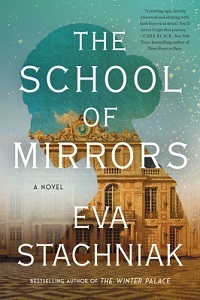 Stachniak casts empathetic light on a French mother and daughter whose lives are affected by royal privilege.
Stachniak casts empathetic light on a French mother and daughter whose lives are affected by royal privilege. By 1755, Louis XV, weary of court formalities and dramas, has become a “connoisseur of innocence,” so his valet de chambre procures untouched teenage girls for his pleasures. Believing she’ll be entering domestic service, pretty, lower-class Véronique Roux arrives at a house near the Versailles palace and gets instructed in the courtesan’s arts. Her patron’s identity is kept concealed, and Véronique loses access to their daughter, Marie-Louise, after her birth.
Marie-Louise becomes a skilled midwife though often wonders about the parents she never knew. As revolutionary fervor builds, her secret royal heritage could become a liability if it’s discovered.
Stachniak combines a delicately embroidered historical world with enduring situations, like the exploitation of the less fortunate and parent-child relationships. Her multifaceted approach also showcases Queen Marie Leszczyńska’s charity work and a fascinating cloth mannequin used to train midwives.
The theme of illusion versus authenticity emerges in subtle ways. This accomplished novel should enthrall Francophiles and women’s history enthusiasts.
The School of Mirrors will be published next week by William Morrow; I turned in this review for Booklist, and the final review was published in their January 1st issue.
Some background information:
- The house where Véronique resides during her time as a mistress-in-training (and later mistress in fact) was a real place called Parc-aux-Cerfs, or Deer Park, as it's called in the novel. Read more about it at the This Is Versailles blog.
- Angelique Marguerite Le Boursier du Coudray, known as Madame du Coudray, was a pioneering midwife who trained other women across France in her profession. Her cloth mannequin, called the "machine," is a cloth anatomical model used to demonstrate the birthing process, and a photo can be found on her Wikipedia page. Stachniak shares more information in her author's note about Madame du Coudray's revolutionary teaching methods, and how they gave young women agency in a world dominated by powerful men.
- Stachniak is also the author of other recommended historical novels about historical women, including The Chosen Maiden about choreographer Bronislava Nijinska; The Winter Palace and Empress of the Night about Catherine the Great; and Garden of Venus, about 19th-century courtesan, and later countess, Sophie Potocka.
Published on February 17, 2022 06:30
February 14, 2022
Some romantic historical reads for Valentine's Day
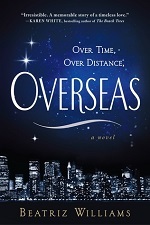 In a comment to a recent post, Tiffany asked about “some recommendations or your favorite romances for some good Valentine's Day reading.” I pondered this for a while, since I don’t currently read a lot of genre romances; I enjoy them, but my reviewing schedule doesn’t allow me to dive into these books as much as I’d like.
In a comment to a recent post, Tiffany asked about “some recommendations or your favorite romances for some good Valentine's Day reading.” I pondered this for a while, since I don’t currently read a lot of genre romances; I enjoy them, but my reviewing schedule doesn’t allow me to dive into these books as much as I’d like. But if we’re talking about love stories across the entire historical fiction spectrum, I can easily provide some recommendation on that score. Many of these novels are best described as historical fiction with romantic elements. I tend to go for deeper themes in my romances, rather than lighter, fluffier fare. Also, most are older titles that could be described as classics.
These are in no particular order. Please share your own favorites in the comments.
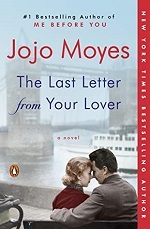 Jojo Moyes, The Last Letter from Your Lover, a dual-period romantic mystery, set in 1960 and over forty years later, about a woman who developed amnesia after a terrible car accident, and who starts questioning the truth about her marriage after finding a mysterious love letter. The movie adaptation (which I thought was just okay) oversimplified the story and omitted one of my favorite parts. This prompted me to reread the novel, which was as good as I remembered.
Jojo Moyes, The Last Letter from Your Lover, a dual-period romantic mystery, set in 1960 and over forty years later, about a woman who developed amnesia after a terrible car accident, and who starts questioning the truth about her marriage after finding a mysterious love letter. The movie adaptation (which I thought was just okay) oversimplified the story and omitted one of my favorite parts. This prompted me to reread the novel, which was as good as I remembered. Madeline Hunter’s medieval romances, including By Arrangement and By Design, set in 14th-century London and which feature characters from different social classes. I wish medieval romances were still in vogue so we could see more like this.
Overseas by Beatriz Williams, her first novel, a complex time-travel story about a modern American woman and a British officer in the Great War. Julian Ashford is a wonderful, honorable hero in this timeless love story.
Tempest by Beverly Jenkins, a mail-order bride romance with plenty of surprises, featuring African American characters in the Old West.
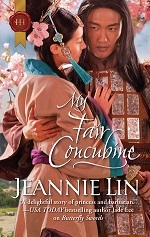
Meredith Duran’s Duke of Shadows, another first novel (from 2008), a meaty Victorian romance with a biracial hero, set in India and England, with exquisite writing which is unafraid to delve into darker issues.
Jeannie Lin’s My Fair Concubine, part of her Tang Dynasty series, a nuanced love story about honor, duty, and class differences with a new take on the classic “My Fair Lady” scenario.
Passing Glory by Reay Tannahill, one of my favorites of her sprawling romantic sagas, which begins in early 20th century England and spans fifty years. It won the Romantic Novelists’ Association’s Novel of the Year, and the ending is most definitely earned.
The Dutch Girl by Donna Thorland, which I read last year; it’s a full-bodied historical novel of American Revolution-era New York, with strong romantic elements and a plotline involving adventure, secret identities, and the history of Dutch settlement in America. The attention to historical detail is impressive.
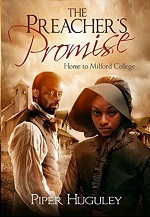
Piper Huguley’s Home to Milford College series, romantic historical fiction set in the Reconstruction-era South, about the love story between two African American characters who found a fictional historically Black college. Start with The Preacher’s Promise.
Pamela Belle’s Heron Saga, a family saga and star-crossed love story of 17th-century England, published in the 1980s and reissued by Lume Books, so new readers will get a chance to discover them.. The Moon in the Water is book one.
Beau Crusoe by Carla Kelly, a Regency romance involving a troubled hero suffering from PTSD and a widow struggling to overcome a scandalous past. I first wrote about it here.
Published on February 14, 2022 05:00
February 11, 2022
Interview with Heather Webb, author of The Next Ship Home: A Novel of Ellis Island
Thanks to author Heather Webb for stopping by Reading the Past for an interview about her new novel The Next Ship Home (Sourcebooks, Feb. 2022), which offers a unique lens on the American immigration story. Through the perspectives of two young women in the early 20th century -- aspiring translator Alma, the daughter in a German family who becomes a matron at Ellis Island, and Francesca, a newly arrived Italian immigrant -- I was quickly drawn into a sweeping story about cultural prejudice, corruption, the complications of family, and a surprising friendship.
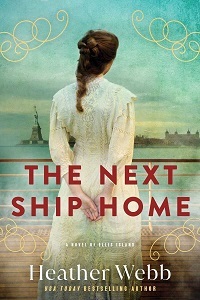 I’ve read many historical novels dealing with immigration to America, but yours is the first that centered on operations at Ellis Island itself. All the details were fascinating to read about. What inspired you to focus your attention on what took place there?
I’ve read many historical novels dealing with immigration to America, but yours is the first that centered on operations at Ellis Island itself. All the details were fascinating to read about. What inspired you to focus your attention on what took place there?
The very first time I visited Ellis Island I was a high school teacher on a field trip with students. I was absolutely riveted by the place. There’s a real presence in those halls…so many people, so many stories to be told. I think, also, being a lover of language and culture—and a military brat—has always made the study of those trying to assimilate to a culture not their own has always fascinated me. I could relate in many ways. It’s funny that when I first started writing, I knew I wanted to write a book about Ellis Island but I also knew I wasn’t ready. Something inside me warned me that I needed to practice more, try other books and ideas, before it was time to sit down and tackle such a grand, challenging topic. I’m glad I listened to my intuition.
What resources did you use to re-create the duties and mindset of Alma, a matron at Ellis Island whose job involved assisting female immigrants and families?
I read several books about the operations at Ellis Island and I also mined information from a ton of immigrant interviews. Though there weren’t a lot of specifics on the day-to-day of a matron, there was just enough that I could glean the basics and fill in the rest. I also found helpful information on the plaques and in the videos at the immigration center on Ellis Island.
As a language aficionado myself, I rooted for Alma and her yearning to become a translator. I also enjoyed seeing her improve her repertoire of world languages, and the theme of how languages are a bridge to cultural understanding. How did you get interested in this topic?
I’m a former French and Spanish teacher and I thoroughly love language-learning in all its forms. I’m really fascinated by the way language reflects culture and how, in kind, culture shapes language. I enjoy studying how language has changed over time as well. I suppose you could say Alma was my ode to the language teacher inside me.
How did you decide on the approach to tell the story from two women’s alternating perspectives?
I knew I wanted to explore different classes of Americans from the newly-arrived immigrants to the first-generation Americans, as well as the wealthy, more established. As well, I wanted to depict the opposing perspectives of immigrant and worker to show the complexity of the immigration system. It’s very rarely a simple thing.
Ellis Island is enshrined in many family histories as a place of hope and new beginnings. Human nature being what it is, I shouldn’t have been surprised at the corruption and abuse that took place at Ellis Island, and which the immigrant characters unfortunately deal with. Were there any facts that took you by surprise as you researched this aspect of the novel?
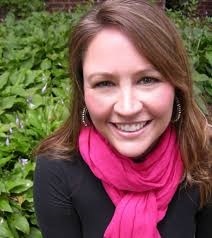 author Heather WebbMany! I really enjoyed reading about Teddy Roosevelt’s place in shaping immigration reform as well as his visit to the island in the fall of 1903. It was a horrible, stormy day and the boat carrying him and his staff nearly capsized in the swell of the bay. When he arrived to the island, very late to the elaborate lunch they’d planned, the food was cold but they did manage to serve oysters for which the Hudson Bay used to be famous, and also champagne. There are so many more facts, too, about the anarchists like Emma Goldman, President McKinley’s assassination, and much more. In truth, I had a hard time narrowing down what the story was truly about during the first few drafts.
author Heather WebbMany! I really enjoyed reading about Teddy Roosevelt’s place in shaping immigration reform as well as his visit to the island in the fall of 1903. It was a horrible, stormy day and the boat carrying him and his staff nearly capsized in the swell of the bay. When he arrived to the island, very late to the elaborate lunch they’d planned, the food was cold but they did manage to serve oysters for which the Hudson Bay used to be famous, and also champagne. There are so many more facts, too, about the anarchists like Emma Goldman, President McKinley’s assassination, and much more. In truth, I had a hard time narrowing down what the story was truly about during the first few drafts.
Reproducing international languages and accents in dialogue can be tricky, because the effect can easily be overdone, but this isn’t the case with Francesca. Everything read as very natural to me. What suggestions do you have for other authors about writing dialogue for characters still gaining fluency in English?
First of all, thank you for the compliment. It’s not an easy thing and yet, I think it’s important to distinguish differences in the characters’ language. I’m a freelance editor and teacher as well so I usually recommend to my students to think of dialect and foreign language as a seasoning in a dish. Salt makes a dish delicious with just the right amount but it must be sprinkled with caution. Too much makes the dish inedible.
Since The Next Ship Home takes place in the United States, did you find the research any easier or different than it was for your previous novels?
Overall, I’d say it wasn’t easier because I’m always interested in international travel and I’m the first one on that plane, but it’s certainly true that living not far from New York City made my research much more accessible (and cheaper!). I took many trips to Ellis Island and into the city itself, and I also used the public library and its archives in the city to gather information and photos, trinkets, etc.
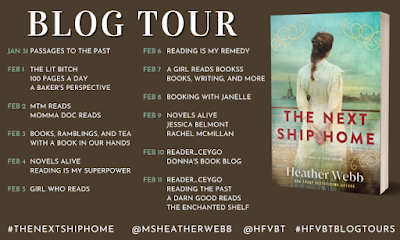
About the author:
Heather Webb is a USA Today bestselling and award-winning author of historical fiction. In 2017, Last Christmas in Paris won the Women’s Fiction Writers Association award, and in 2019, Meet Me in Monaco was shortlisted for both the RNA award in the UK and also the Digital Book World Fiction prize. Heather’s new solo novel The Next Ship Home is about unlikely friends that confront a corrupt system, altering their fates and the lives of the immigrants who come after them. When not writing, Heather flexes her foodie skills, geeks out on pop culture and history, or looks for excuses to head to the other side of the world. For more information, please visit Heather’s website.
 I’ve read many historical novels dealing with immigration to America, but yours is the first that centered on operations at Ellis Island itself. All the details were fascinating to read about. What inspired you to focus your attention on what took place there?
I’ve read many historical novels dealing with immigration to America, but yours is the first that centered on operations at Ellis Island itself. All the details were fascinating to read about. What inspired you to focus your attention on what took place there? The very first time I visited Ellis Island I was a high school teacher on a field trip with students. I was absolutely riveted by the place. There’s a real presence in those halls…so many people, so many stories to be told. I think, also, being a lover of language and culture—and a military brat—has always made the study of those trying to assimilate to a culture not their own has always fascinated me. I could relate in many ways. It’s funny that when I first started writing, I knew I wanted to write a book about Ellis Island but I also knew I wasn’t ready. Something inside me warned me that I needed to practice more, try other books and ideas, before it was time to sit down and tackle such a grand, challenging topic. I’m glad I listened to my intuition.
What resources did you use to re-create the duties and mindset of Alma, a matron at Ellis Island whose job involved assisting female immigrants and families?
I read several books about the operations at Ellis Island and I also mined information from a ton of immigrant interviews. Though there weren’t a lot of specifics on the day-to-day of a matron, there was just enough that I could glean the basics and fill in the rest. I also found helpful information on the plaques and in the videos at the immigration center on Ellis Island.
As a language aficionado myself, I rooted for Alma and her yearning to become a translator. I also enjoyed seeing her improve her repertoire of world languages, and the theme of how languages are a bridge to cultural understanding. How did you get interested in this topic?
I’m a former French and Spanish teacher and I thoroughly love language-learning in all its forms. I’m really fascinated by the way language reflects culture and how, in kind, culture shapes language. I enjoy studying how language has changed over time as well. I suppose you could say Alma was my ode to the language teacher inside me.
How did you decide on the approach to tell the story from two women’s alternating perspectives?
I knew I wanted to explore different classes of Americans from the newly-arrived immigrants to the first-generation Americans, as well as the wealthy, more established. As well, I wanted to depict the opposing perspectives of immigrant and worker to show the complexity of the immigration system. It’s very rarely a simple thing.
Ellis Island is enshrined in many family histories as a place of hope and new beginnings. Human nature being what it is, I shouldn’t have been surprised at the corruption and abuse that took place at Ellis Island, and which the immigrant characters unfortunately deal with. Were there any facts that took you by surprise as you researched this aspect of the novel?
 author Heather WebbMany! I really enjoyed reading about Teddy Roosevelt’s place in shaping immigration reform as well as his visit to the island in the fall of 1903. It was a horrible, stormy day and the boat carrying him and his staff nearly capsized in the swell of the bay. When he arrived to the island, very late to the elaborate lunch they’d planned, the food was cold but they did manage to serve oysters for which the Hudson Bay used to be famous, and also champagne. There are so many more facts, too, about the anarchists like Emma Goldman, President McKinley’s assassination, and much more. In truth, I had a hard time narrowing down what the story was truly about during the first few drafts.
author Heather WebbMany! I really enjoyed reading about Teddy Roosevelt’s place in shaping immigration reform as well as his visit to the island in the fall of 1903. It was a horrible, stormy day and the boat carrying him and his staff nearly capsized in the swell of the bay. When he arrived to the island, very late to the elaborate lunch they’d planned, the food was cold but they did manage to serve oysters for which the Hudson Bay used to be famous, and also champagne. There are so many more facts, too, about the anarchists like Emma Goldman, President McKinley’s assassination, and much more. In truth, I had a hard time narrowing down what the story was truly about during the first few drafts. Reproducing international languages and accents in dialogue can be tricky, because the effect can easily be overdone, but this isn’t the case with Francesca. Everything read as very natural to me. What suggestions do you have for other authors about writing dialogue for characters still gaining fluency in English?
First of all, thank you for the compliment. It’s not an easy thing and yet, I think it’s important to distinguish differences in the characters’ language. I’m a freelance editor and teacher as well so I usually recommend to my students to think of dialect and foreign language as a seasoning in a dish. Salt makes a dish delicious with just the right amount but it must be sprinkled with caution. Too much makes the dish inedible.
Since The Next Ship Home takes place in the United States, did you find the research any easier or different than it was for your previous novels?
Overall, I’d say it wasn’t easier because I’m always interested in international travel and I’m the first one on that plane, but it’s certainly true that living not far from New York City made my research much more accessible (and cheaper!). I took many trips to Ellis Island and into the city itself, and I also used the public library and its archives in the city to gather information and photos, trinkets, etc.

About the author:
Heather Webb is a USA Today bestselling and award-winning author of historical fiction. In 2017, Last Christmas in Paris won the Women’s Fiction Writers Association award, and in 2019, Meet Me in Monaco was shortlisted for both the RNA award in the UK and also the Digital Book World Fiction prize. Heather’s new solo novel The Next Ship Home is about unlikely friends that confront a corrupt system, altering their fates and the lives of the immigrants who come after them. When not writing, Heather flexes her foodie skills, geeks out on pop culture and history, or looks for excuses to head to the other side of the world. For more information, please visit Heather’s website.
Published on February 11, 2022 05:00
February 6, 2022
The Magnolia Palace by Fiona Davis offers an exciting, artistic escape into New York City's past
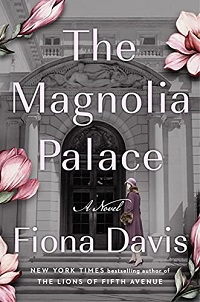 Fiona Davis’s novels offer the vicarious pleasures of getting an exclusive tour of New York City’s iconic landmarks. Her latest work centers on the Henry Clay Frick House, once a Gilded Age mansion, now a public museum and art library. While envisioning the gorgeous paintings, sculptures, and other precious objects inside the building (whose Fifth Avenue garden is adorned by large magnolias) is a highlight, the colorful personalities could carry the novel on its own.
Fiona Davis’s novels offer the vicarious pleasures of getting an exclusive tour of New York City’s iconic landmarks. Her latest work centers on the Henry Clay Frick House, once a Gilded Age mansion, now a public museum and art library. While envisioning the gorgeous paintings, sculptures, and other precious objects inside the building (whose Fifth Avenue garden is adorned by large magnolias) is a highlight, the colorful personalities could carry the novel on its own. By 1919, Lillian Carter has spent six years posing for public sculptures across New York under the name “Angelica.” While she’s enjoyed contributing to the city’s art scene, a murder scandal involving her landlord forces her to go into hiding.
A twist of fate propels Lillian into the role of private secretary to Helen Clay Frick, the industrialist’s mercurial 31-year-old daughter, who’s torn between pursuing her own interests and seeking her critical father’s approval. Lillian proves remarkably successful in her tasks, but while she dreams of a silent movie career, a secret assignment, one that’s too temptingly profitable to resist, ensnares her in longstanding Frick family tensions.
Decades later, in 1966, English model Veronica Weber secures a lucrative modeling assignment at the Frick Collection, but after the job turns sour, she finds herself accidentally trapped in the building overnight alongside a handsome African American museum intern. Initially watchful of one another, they team up to follow clues in a scavenger hunt created long ago.
The pages breeze by as potential romances develop (maybe not the ones you’d expect) and a mystery involving the whereabouts of the Magnolia Diamond unfolds. Deeper issues also undergird both narratives, which confront stereotypes about models and explore how a tragedy can warp family relationships years later. The two narratives dovetail in a satisfying way. Mystery and art lovers should relish this exciting escape into New York’s past.
The Magnolia Palace was published by Dutton in January; I reviewed it from NetGalley for February's Historical Novels Review.
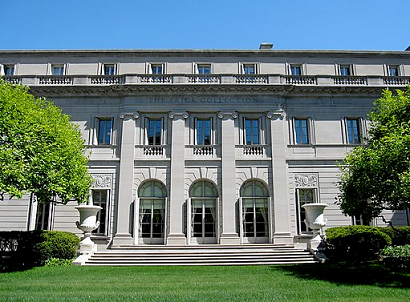 Credit: Gryffindor, CC BY-SA 3.0, via Wikimedia
Credit: Gryffindor, CC BY-SA 3.0, via WikimediaRead more about the Frick Collection at their website. Although I've been to NYC many times, I hadn't been familiar at all with this institution or the personalities surrounding it before reading this book. Now I have a long list of places to visit once travel is possible again.
Published on February 06, 2022 07:12
February 1, 2022
The Books of Jacob by Olga Tokarczuk, her magnum opus about a controversial 18th-century Jewish figure and his world
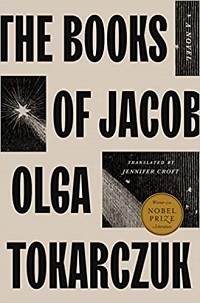 Described as Polish Nobel laureate Tokarczuk’s magnum opus, this impressively sprawling story reveals the life and times of Jacob Frank, an 18th-century Jewish messianic figure. Frank is enigmatically charismatic and incredibly disruptive: a self-described “simpleton,” sporting Turkish garb, who violates social norms.
Described as Polish Nobel laureate Tokarczuk’s magnum opus, this impressively sprawling story reveals the life and times of Jacob Frank, an 18th-century Jewish messianic figure. Frank is enigmatically charismatic and incredibly disruptive: a self-described “simpleton,” sporting Turkish garb, who violates social norms. Opening in 1752 in Rohatyn, a Polish market town, and passing through numerous other European and Ottoman locales, the narrative expertly delves into the circumstances that shaped and elevated him. Forbidden from buying land and overburdened by taxes, many Jews seek deliverance. In this bizarre, intricate journey based in history, Frank and his followers come to reject the Talmud and, eventually, convert to Catholicism.
With language that’s engaging, erudite, and spiced with witty colloquialisms and wonderful turns of phrase via Jennifer Croft’s supple translation, Tokarczuk explores the state of being an outsider in places with fixed cultural boundaries and how Frank tries to work the system to advantage. Among the intriguing, diverse cast are Nahman, Frank’s ardent supporter, and Yente, a dying woman whose spirit views events from above.
There’s so much fine quotidian detail you’ll feel you’ve stepped into the novel’s canvas, while the overarching threads connect brilliantly. With its length, dozens of characters (some of whom adopt new names), and theological discussions, this panoramic tale requires commitment, but it’s masterfully done.
The Books of Jacob is published today by Riverhead in the US; it appeared in the UK last year from Fitzcarraldo Editions. I submitted this review for Booklist, and it was published (in shorter form) in the Dec. 1, 2021 issue.
This book is 992pp long, and the lengthiest novel I've ever read on my Kindle (I got it from NetGalley). It took me three weeks to read, and my Goodreads challenge definitely suffered. A note from the publisher says: "In a nod to books written in Hebrew, The Books of Jacob is paginated in reverse, beginning on p. 955 and ending on p. 1 – but read traditionally, front cover to back." This wasn't apparent from my copy, but it's an appropriate and cool feature. The translation from Polish by Jennifer Croft reportedly took seven years to complete.
As you can imagine, writing a 200-odd word review of a nearly thousand-page historical novel necessitates leaving out a lot, so tough decisions had to be made on what to include in my writeup. I was given a choice as to what I might like to review and selected The Books of Jacob because (1) the historical period is one I knew very little about beforehand; (2) a branch of my family comes from the area where part of this book takes place; (3) I couldn't resist the opportunity to be among the first to read this internationally acclaimed novel in English, as I'd heard a lot about it; and (4) after reading through the first chapter of the NetGalley copy, I was sold and wanted to continue.
Jacob Frank is a historical character, and his story as presented by Tokarczuk is utterly strange and based in truth. His story, and that of religious and social life at the time, is related through the eyes of numerous other characters, and it's left to interpretation as to whether Jacob is a charismatic con artist or a shrewd observer who determines an ingenious, unorthodox way to raise the Jews' status in society. There are no references to Jacob himself until a good ways in. You may find yourself wondering when he'll finally make an appearance on the page, but by the time he does, you'll have a detailed picture of the unique circumstances surrounding him and the movement he creates.
Reviewing for the New York Times, Dwight Garner calls it "sophisticated and overwhelming," both of which are true. His conclusion also agrees with my experience. Read his take on the novel here.
Published on February 01, 2022 04:00
January 29, 2022
More historical fiction award news: Langum Prize and National Jewish Book Awards
It seems to be the season for book awards. The honorees for the 2021 Langum Prize in American Historical Fiction were announced earlier this week, and the 2022 winners of the National Jewish Book Awards were named last week. Here are the details relevant for historical fiction readers.
The Langum Prize:
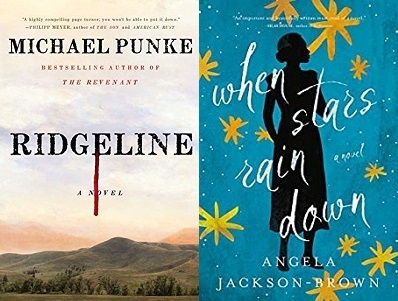
Ridgeline by Michael Punke, which revisits the scene of the Fetterman massacre, a violent clash between white settlers and the Lakota in 1866 Wyoming, is the winner of the 2021 Langum Prize.
The Langum Prize finalist for 2021 is When Stars Rain Down by Angela Jackson-Brown, the coming-of-age story of a young Black woman in Depression-era Georgia. Read my earlier review of this excellent novel.
National Jewish Book Awards:
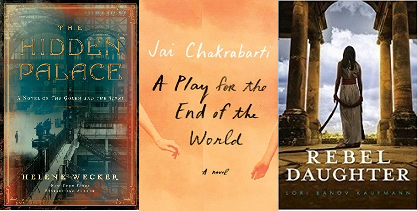
Sponsored by the Jewish Book Council, the National Jewish Book awards are presented annually for Jewish literature in a wide variety of categories. Links lead to the reviews or descriptions at the JBC website.
In the Book Club category, the winner is Helene Wecker's The Hidden Palace, a sequel to her historical fantasy novel The Golem and the Jinni, a cross-cultural immigrant story set in early 20th-century NYC.
Finalists in the Book Club category are Weina Dai Randel's The Last Rose of Shanghai (an epic love story of WWII Shanghai that I reviewed earlier) and Yaniv Iczkovits' (trans. Orr Scharf) The Slaughterman's Daughter (about a young woman's disappearance in the Pale of Settlement in the late 19th century).
For Debut Fiction, the winner is Jai Chakrabarti's A Play for the End of the World, which moves from the Warsaw Ghetto to India in the 1970s as it examines the themes of friendship, love, and the purpose of art.
Lori Banov Kaufmann's Rebel Daughter, a young woman's perspective on the destruction of Jerusalem in 70 CE, won the award for Young Adult Literature.
If you've read any, I'd love to hear your thoughts. Congratulations to all the honorees!
The Langum Prize:

Ridgeline by Michael Punke, which revisits the scene of the Fetterman massacre, a violent clash between white settlers and the Lakota in 1866 Wyoming, is the winner of the 2021 Langum Prize.
The Langum Prize finalist for 2021 is When Stars Rain Down by Angela Jackson-Brown, the coming-of-age story of a young Black woman in Depression-era Georgia. Read my earlier review of this excellent novel.
National Jewish Book Awards:

Sponsored by the Jewish Book Council, the National Jewish Book awards are presented annually for Jewish literature in a wide variety of categories. Links lead to the reviews or descriptions at the JBC website.
In the Book Club category, the winner is Helene Wecker's The Hidden Palace, a sequel to her historical fantasy novel The Golem and the Jinni, a cross-cultural immigrant story set in early 20th-century NYC.
Finalists in the Book Club category are Weina Dai Randel's The Last Rose of Shanghai (an epic love story of WWII Shanghai that I reviewed earlier) and Yaniv Iczkovits' (trans. Orr Scharf) The Slaughterman's Daughter (about a young woman's disappearance in the Pale of Settlement in the late 19th century).
For Debut Fiction, the winner is Jai Chakrabarti's A Play for the End of the World, which moves from the Warsaw Ghetto to India in the 1970s as it examines the themes of friendship, love, and the purpose of art.
Lori Banov Kaufmann's Rebel Daughter, a young woman's perspective on the destruction of Jerusalem in 70 CE, won the award for Young Adult Literature.
If you've read any, I'd love to hear your thoughts. Congratulations to all the honorees!
Published on January 29, 2022 06:00
January 24, 2022
Historical fiction award winners announced at the 2022 American Library Association LibLearnX conference
Yesterday afternoon, I tuned in to watch the 2022 Book & Media Award announcements from the American Library Association's RUSA Division. The event was broadcast on Facebook and YouTube (which my husband set up so I could watch on our TV). Our tortie cat Cocoa helped, or rather mostly got in the way of the screen. LibLearnX is the new conference that takes the place of ALA Midwinter.
The graphic below with the book covers of four winners, coincidentally, is highly orange!
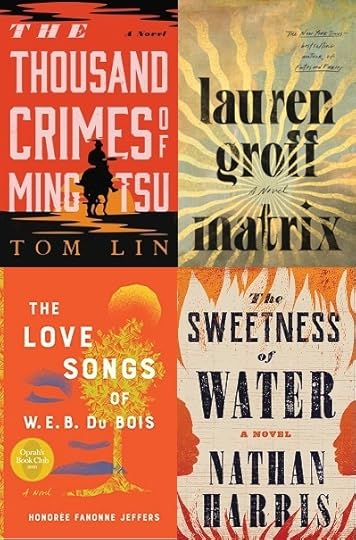
There were three major awards in which historical novels received recognition, so without further ado:
The winner for the Carnegie Medal for Excellence in Fiction was Tom Lin's The Thousand Crimes of Ming Tsu, about a Chinese orphan turned assassin in the post-Civil War West.
On the Notable Books List are several other works of historical fiction:
Jaime Cortez's Gordo, a short story collection set amid a California migrant workers' camp in the '70s (if you count the era as sufficiently historical);
Lauren Groff's Matrix, imagining the life of Marie de France, a French-born abbess in 12th-century England;
Honorée Fanonne Jeffers' The Love Songs of W. E. B. Du Bois, an expansive story tracing the heritage of a young woman's African American family;
and Anthony Doerr's Cloud Cuckoo Land, a historical-futuristic literary epic set partly in 15th-century Constantinople.
And for the Reading List, the ALA's annual awards in eight genre fiction categories, the award for Historical Fiction went to The Sweetness of Water by Nathan Harris, about the unusual friendship between enslaved brothers and a Georgia plantation couple in the post-Civil War years, and a subsequent tragedy.
On the Historical Fiction shortlist are:
Daughters of Sparta by Claire Heywood (a Greek myth retelling):
Leonora in the Morning Light by Michaela Carter (on 20th-century painter Leonora Carrington);The Rose Code by Kate Quinn (suspense before and after Bletchley Park, WWII);and A Tip for the Hangman by Allison Epstein (spy thriller with Christopher Marlowe).
Congrats to all the honorees!
 Miss Cocoa acting as live awards emcee
Miss Cocoa acting as live awards emcee
The graphic below with the book covers of four winners, coincidentally, is highly orange!

There were three major awards in which historical novels received recognition, so without further ado:
The winner for the Carnegie Medal for Excellence in Fiction was Tom Lin's The Thousand Crimes of Ming Tsu, about a Chinese orphan turned assassin in the post-Civil War West.
On the Notable Books List are several other works of historical fiction:
Jaime Cortez's Gordo, a short story collection set amid a California migrant workers' camp in the '70s (if you count the era as sufficiently historical);
Lauren Groff's Matrix, imagining the life of Marie de France, a French-born abbess in 12th-century England;
Honorée Fanonne Jeffers' The Love Songs of W. E. B. Du Bois, an expansive story tracing the heritage of a young woman's African American family;
and Anthony Doerr's Cloud Cuckoo Land, a historical-futuristic literary epic set partly in 15th-century Constantinople.
And for the Reading List, the ALA's annual awards in eight genre fiction categories, the award for Historical Fiction went to The Sweetness of Water by Nathan Harris, about the unusual friendship between enslaved brothers and a Georgia plantation couple in the post-Civil War years, and a subsequent tragedy.
On the Historical Fiction shortlist are:
Daughters of Sparta by Claire Heywood (a Greek myth retelling):
Leonora in the Morning Light by Michaela Carter (on 20th-century painter Leonora Carrington);The Rose Code by Kate Quinn (suspense before and after Bletchley Park, WWII);and A Tip for the Hangman by Allison Epstein (spy thriller with Christopher Marlowe).
Congrats to all the honorees!
 Miss Cocoa acting as live awards emcee
Miss Cocoa acting as live awards emcee
Published on January 24, 2022 16:00
January 20, 2022
Out Front the Following Sea by Leah Angstman, a tale of female strength and survival in early New England
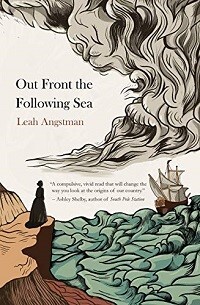 Hang on tight for a bracing read about a young woman’s strength in the wilderness and towns of late 1680s New England.
Hang on tight for a bracing read about a young woman’s strength in the wilderness and towns of late 1680s New England. The courageous heroine of Leah Angstman’s debut novel is Ruth Miner, just sixteen when she’s forced to endure the frigid winter temperatures while caring for her elderly grandmother, suffering from dementia, in their spartan cabin near Shrewsbury, East Jersey Province. Considered an outcast following suspicion that she killed her parents through witchcraft, Ruth knows she must shoulder her burdens alone. Being an independent woman in this time and place, though, is dangerous, a theme carried through the entire novel.
Ruth’s one initial ally is a sea captain’s half-French son, Owen Townsend, who knows the truth about her past. After her grandmother’s inevitable death, Ruth knows she needs to flee a mob of angry townspeople and wangles a spot aboard Owen’s ship, the Primrose, as freight (not a fun prospect!) since all the passenger slots are filled.
Arriving in the coastal settlement of Stonington in Connecticut Colony, Ruth finds a quasi-home with a Quaker couple, though pressure mounts for her to find a husband. Owen, however, must be off on another voyage just as an older merchant comes seeking her hand. Meanwhile, despite a prevailing treaty, tensions between the English and French are heating up in the colonies, leading ultimately to King William’s War.
The atmosphere feels raw, the setting untamed, the characters stubborn and full of purpose. The author’s muscular language does much heavy lifting in evoking the time through original expressions and an impressive command of period vocabulary. Many insults are worth jotting down for future use (“You fewmet of a boar!” “Ale-soused applejohn!”).
Fast-paced action, an emotional love story, race relations, and international political intrigue intermingle in a compelling way. The author makes some impressively daring choices with her characters’ lives. At times the narrative feels whittled down from a longer book, since there are some gaps where we don’t get to see how characters got from point A to point B.
Few novels depict this troubled time in American colonial history, or early Connecticut, for that matter, and Ruth is a heroine well worth following on her dramatic journey of survival.
Out Front the Following Sea was published in January by Regal House; I reviewed it from an Edelweiss e-copy as part of the tour for Historical Fiction Virtual Book Tours.
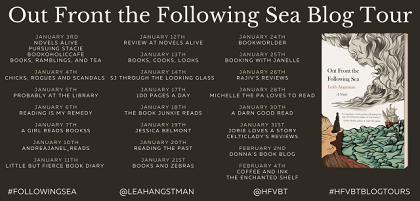
Published on January 20, 2022 05:00
January 17, 2022
Love & Saffron by Kim Fay, an epistolary novel of food and women's friendship in 1960s America
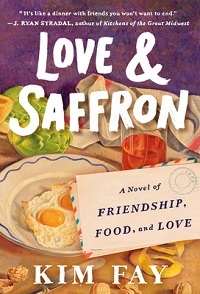 Fiction and culinary travel writer Fay (The Map of Lost Memories, 2012) has crafted a delectable second novel showing how food can bring people together, even across distances and cultures.
Fiction and culinary travel writer Fay (The Map of Lost Memories, 2012) has crafted a delectable second novel showing how food can bring people together, even across distances and cultures. In October 1962, Joan Bergstrom, an unmarried 27-year-old from L.A., sends an admiring fan letter to Mrs. Imogen Fortier, author of a magazine column on Pacific Northwest island life. To thank her, Joan shares a favorite mussels recipe and encloses a saffron packet.
The story is mostly told via the women’s warm-hearted correspondence. They become close while exchanging thoughts on food, their personal lives, and contemporary society.
Their connection nurtures them during tough times and draws in others as well. Imogen’s WWI-veteran husband, Francis, impresses her with his newfound interest in French cooking, while Joan’s friendship with her neighbors’ Mexican carpenter, begun over a shared meal, develops into something more.
Fay’s emotionally generous novel demonstrates how people’s worlds can expand when they open themselves to new possibilities. Readers will be touched by this enriching tale and inspired to embark on their own international culinary adventures.
Love & Saffron will be published by Putnam (US) on February 8th; I reviewed it for the Nov. 1, 2021 issue of Booklist. The novel is 192pp long, and you can read it in an afternoon (which I did). There are many scrumptious-sounding dishes described within, so prepare to start googling for recipes.
This novel is very different in style and tone from her first novel, a quest-adventure set in 1920s Shanghai and Cambodia, and which I'd also reviewed back in 2012. I'd also interviewed Kim Fay about The Map of Lost Memories, and she spoke then about her interest in food and cooking.
Published on January 17, 2022 08:28
January 12, 2022
In Love, In War: a guest post by Margaret Walker, author of Through Forests and Mountains
I'm happy to welcome Australian novelist Margaret Walker for a guest post about the background to her latest historical fiction work, Through Forests and Mountains (Penmore, 2021), which focuses on the Partisan women in WWII Yugoslavia.
~
In Love, In War
by Margaret Walker
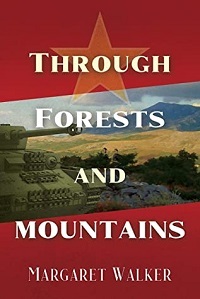 How many women do you know who commence an historical novel based on their shoe size? Or their head circumference? Or their height? When I was growing up in Sydney in the 1960s, all three were expected to be British, and the British were small.
How many women do you know who commence an historical novel based on their shoe size? Or their head circumference? Or their height? When I was growing up in Sydney in the 1960s, all three were expected to be British, and the British were small.
I was an eight-pound twin. I was adopted at birth and my mother came from Yugoslavia, the home of large people.
I grew up hating shoes. All they ever did was hurt. I hated shopping. Nothing fitted, and I developed an early and permanent fixation about my size.
Then, in 1970, something wonderful happened. My adoptive mother told me about the women of the Yugoslav Partisans in World War 2 who had battled the Nazis alongside the men. She did it to console me – even at ten I could tell that – and with that heightened sense of romanticism that novelists are born with, I just knew that my biological mother had hurled grenades at cowering Germans. I felt a fierce pride that half of me had been involved in the Struggle for National Liberation, as it was called and, from that day, I was on a mission to teach my small-footed, small-headed world the history that justified every pair of shoes that had ever given me blisters. But first I treated my disproportionate self to a tour of the old Yugoslavia where, at long last, I met women my size.
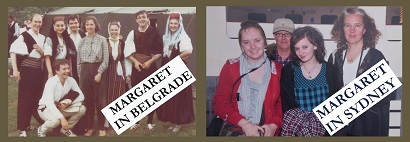
My first novel His Most Italian City, about the persecution of my birth mother’s family under Mussolini, was published by Penmore Press in Arizona in 2019 and, with the confidence that gave me, I began to write Through Forests and Mountains about the Partisan women. In 2015, Jelena Batinić published a fabulous book called Women and Yugoslav Partisans, and in 2018 I bought a book of Partisan poems in Croatian, of which I translated about forty. "A Woman Under Arms" by Franjo Mraz is my favourite:
Oh, my rifle, I will never part with you!
You will be with me at the end of my wrist until the last day
Protecting the paths of freedom along which the conquered are moving.
Tremble, look, and listen to the woman warrior, the woman partisan!
So, like me, you want to tell the world about your obsession? You are in distinguished company, and I suggest that two things are essential. One, make your readers care about your protagonist from the first page. You must carry them along emotionally. Two: be such a sensational writer that you can make your reader passionate about carburettors, sushi and Tibetan Mastiffs.
Not interested in the Yugoslav Partisans?
I’m going to make you interested. Great style, emotional characters, racy plot, and a seriously nasty villain.
In the planning stages, I considered what the premise of a novel about women fighters ought to be and, after a few false starts, I decided to tell the story of a man who, in the ordinary course of his life, has trouble with women. He’s mechanical. He’s hopeless at female games. His love life is a series of brief, shallow relationships. However, as the war progresses, he finds himself in a position where he is forced to deal with women fighters.
How he responds to this provides the conflict, and conflict is important in novel writing. It gives the reader interest. In order to resolve it, I toyed with the idea of introducing romantic elements between him and the female protagonist.
Here I encountered a problem.
The Yugoslav Partisans were not allowed romance. The Anti-Fascist struggle was too important. The women who fought became hardened until they were almost like eunuchs. Their periods stopped. If they had children, they left them in the care of others and went off to fight.
Then I discovered the poems of Josip Cazi, a political commissar with the Partisans. As I read his verses, a picture emerged of a soldier whom I imagined might ‘lay his rifle tenderly next to hers’. So many of his poems were about his relationships with women, and their style is remarkably sentimental for wartime.
‘Jelice, my apple girl in blue. My partisan rose with the wild hair in the blushing dawn, in pearls of dew. My small hero.’
If he can do it, I can do it, I thought. (And, despite the rules, there must have been some fun and games amongst the Partisans because Jelena Batinić includes a quote from a German who observed that many of the women were pregnant.)
From that moment, my male protagonist was doomed to be smitten, poor fellow, and I hope I have made this clear to the reader from the beginning of the novel. By the time my manuscript assessor suggested that I might like to develop my dot-pointed romance, the horse had bolted, and honestly it was so much fun to write that I almost considered going in for the whole Mills and Boon thing – Her Gun at his Heart, A War on More Fronts Than He Anticipated, Surrender! – and so forth.
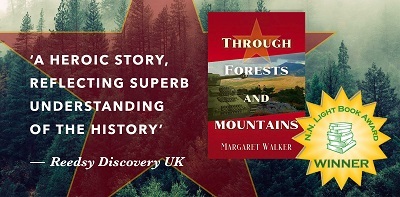
~
In Love, In War
by Margaret Walker
 How many women do you know who commence an historical novel based on their shoe size? Or their head circumference? Or their height? When I was growing up in Sydney in the 1960s, all three were expected to be British, and the British were small.
How many women do you know who commence an historical novel based on their shoe size? Or their head circumference? Or their height? When I was growing up in Sydney in the 1960s, all three were expected to be British, and the British were small. I was an eight-pound twin. I was adopted at birth and my mother came from Yugoslavia, the home of large people.
I grew up hating shoes. All they ever did was hurt. I hated shopping. Nothing fitted, and I developed an early and permanent fixation about my size.
Then, in 1970, something wonderful happened. My adoptive mother told me about the women of the Yugoslav Partisans in World War 2 who had battled the Nazis alongside the men. She did it to console me – even at ten I could tell that – and with that heightened sense of romanticism that novelists are born with, I just knew that my biological mother had hurled grenades at cowering Germans. I felt a fierce pride that half of me had been involved in the Struggle for National Liberation, as it was called and, from that day, I was on a mission to teach my small-footed, small-headed world the history that justified every pair of shoes that had ever given me blisters. But first I treated my disproportionate self to a tour of the old Yugoslavia where, at long last, I met women my size.

My first novel His Most Italian City, about the persecution of my birth mother’s family under Mussolini, was published by Penmore Press in Arizona in 2019 and, with the confidence that gave me, I began to write Through Forests and Mountains about the Partisan women. In 2015, Jelena Batinić published a fabulous book called Women and Yugoslav Partisans, and in 2018 I bought a book of Partisan poems in Croatian, of which I translated about forty. "A Woman Under Arms" by Franjo Mraz is my favourite:
Oh, my rifle, I will never part with you!
You will be with me at the end of my wrist until the last day
Protecting the paths of freedom along which the conquered are moving.
Tremble, look, and listen to the woman warrior, the woman partisan!
So, like me, you want to tell the world about your obsession? You are in distinguished company, and I suggest that two things are essential. One, make your readers care about your protagonist from the first page. You must carry them along emotionally. Two: be such a sensational writer that you can make your reader passionate about carburettors, sushi and Tibetan Mastiffs.
Not interested in the Yugoslav Partisans?
I’m going to make you interested. Great style, emotional characters, racy plot, and a seriously nasty villain.
In the planning stages, I considered what the premise of a novel about women fighters ought to be and, after a few false starts, I decided to tell the story of a man who, in the ordinary course of his life, has trouble with women. He’s mechanical. He’s hopeless at female games. His love life is a series of brief, shallow relationships. However, as the war progresses, he finds himself in a position where he is forced to deal with women fighters.
How he responds to this provides the conflict, and conflict is important in novel writing. It gives the reader interest. In order to resolve it, I toyed with the idea of introducing romantic elements between him and the female protagonist.
Here I encountered a problem.
The Yugoslav Partisans were not allowed romance. The Anti-Fascist struggle was too important. The women who fought became hardened until they were almost like eunuchs. Their periods stopped. If they had children, they left them in the care of others and went off to fight.
Then I discovered the poems of Josip Cazi, a political commissar with the Partisans. As I read his verses, a picture emerged of a soldier whom I imagined might ‘lay his rifle tenderly next to hers’. So many of his poems were about his relationships with women, and their style is remarkably sentimental for wartime.
‘Jelice, my apple girl in blue. My partisan rose with the wild hair in the blushing dawn, in pearls of dew. My small hero.’
If he can do it, I can do it, I thought. (And, despite the rules, there must have been some fun and games amongst the Partisans because Jelena Batinić includes a quote from a German who observed that many of the women were pregnant.)
From that moment, my male protagonist was doomed to be smitten, poor fellow, and I hope I have made this clear to the reader from the beginning of the novel. By the time my manuscript assessor suggested that I might like to develop my dot-pointed romance, the horse had bolted, and honestly it was so much fun to write that I almost considered going in for the whole Mills and Boon thing – Her Gun at his Heart, A War on More Fronts Than He Anticipated, Surrender! – and so forth.
'I have spoken with the commissar,' Anton began, 'who has given us permission to marry. If you'd like,' he added.
'Oh...' said Mara and put a hand to her lips. 'Oh.'
Anton waited for her to say something else. When she didn't it was obvious, even to him, that her mind had not been on love.
In an effort to emphasise to her the uniqueness of the privilege granted them he said, 'They don't generally allow it.' Still no reply. He added desperately, 'The commissar's reply ran along the lines of what he thought would be in my best interests, or rather, you understand, our best interests.'
'I understand,’ said Mara.
'What he meant was, I can't go back to sea, so...'
'Marriage might be a sweetener?'
'Well, yes, I expect you could put it like that.’
She started to laugh. That thoughtless, girlish laugh that had so often wounded him. He felt lonelier than ever. He was aware, by then, that he had blown his chance of getting her that little bit closer to him for a longer time, instead of always being part of an army on the move. What might happen tomorrow? Where would they be sent? When would he see her again? What sort of struggle against the Axis powers might it be for him if he no longer had access to her heart? If only he could start again and ask her properly in a way that any young woman would like to be asked. But had he? No. He’d just done it his way, as usual.
But she stopped laughing and looked up at him fondly.
'Of course, I'll marry you, Anton,’ she said. ‘What would I do if you weren’t here?'

Note: Quotations from the poems, translated by Margaret Walker, are from Po Šumama i Gorama, Pjesme Boraca Narodnooslobodilačkog Rata [Through Forests and Mountains, poems of the fighters in the war of national liberation], published in Zagreb in 1952.
~
Margaret Walker is a teacher. She has a Bachelor of Science degree from the University of Sydney, and diplomas in Education and Professional Communication. Her short stories have been published in Australia and England. Visit her author website at: https://www.mwalkeristra.com.
Published on January 12, 2022 06:00



